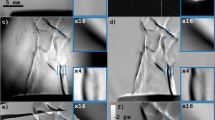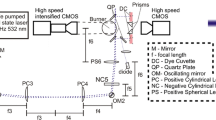Abstract
Stereoscopic imaging and reconstruction of turbulent impinging diffusion flames have been demonstrated. The 3D geometry of the flame surface is reconstructed from any pair of stereo images through digital image processing and computer vision. Only one camera is required to capture the pair of stereo images due to the use of a stereo adapter. As a result the pair of flame images is captured on a single CCD chip. They are then post-processed to produce a 3D geometry of the flame. The 3D results and surface area calculations demonstrate the potential of stereo visualisation, data extraction and the validity of the proposed methodology.

















Similar content being viewed by others
References
Alvarez L, Deriche R, Sánchez J, Weickert J (2002) Dense disparity map estimation respecting image discontinuities: a PDE and scale-space based approach. J Vis Commun Image Represent 13:3–21
Bheemul HC, Lu G, Yan Y (2001) Three-dimensional monitoring and characterisation of gaseous flames using digital image techniques. In: Proc International Conference on Energy, Automation and Information Technology, Indian Institute of Technology, Kharagpur, 10–12 December 2001
Faugeras O (1993) Three-dimensional computer vision: a geometric viewpoint. MIT Press, Cambridge
Fichot F, Delhaye B, Veynante D, Candel SM (1994) Strain rate modelling for a flame surface density equation with application to non-premixed turbulent combustion. In: Proc Twenty-Fifth Symposium (International) on Combustion. The Combustion Institute, Pittsburgh, pp 1273–1281
Foat T, Yap KP, Zhang Y (2001) The visualisation and mapping of turbulent premixed impinging flames. Combust Flame 125:839–851
Jain R, Kasturi R, Schunck BG (1995) Machine vision. McGraw-Hill, New York
Karlovitz B, Denniston DW Jr, Wells FE (1951) J Chem Phys19:541–547
Kollmann W, Chen JH (1994) Dynamics of the flame surface area in turbulent non-premixed combustion. In: Proc Twenty-Fifth Symposium (International) on Combustion. The Combustion Institute, Pittsburgh, pp 1091–1098
Mcallister DF (1994) Stereo computer graphics and other true 3D technologies. Princeton University Press, Princeton
McMackin L, Hugo RJ, Pierson RE, Truman CR (1997) High speed optical tomography system for imaging dynamic transparent media. Opt Express 1:302–311
Meng H, Estevadeirdal J, Gogineni S, Goss L, Roquemore WM (1998) Holographic flow visualization as a tool for studying three-dimensional coherent structures and instabilities. J Visualiz 2:133–144
Milan S, Vaclav H, Roger B (1999) Image processing, analysis, and machine vision. PWS Publishing, Boston
Moratti F, Annunziato M, Bertini I, Giammartini S, Sviluppo (1996) Di un sistema per la ricostruzione tridimensionale e la caratterizzazione dinamica di fiamme industriali, ENEA Report ENEA-MICA EIDE 96019 1DE4A. http://erg055.casaccia.enea.it/imglab/flames.html. Cited 15 July 2002
Pelliccia-Kraft BJ, Watt DW (2000) Three-dimensional imaging of a turbulent jet using shearing interferometry and optical tomography. Exp Fluids 29:573–581
Sturm PF, Maybank SJ (1999) On plane-based camera calibration: ageneral algorithm, singularities, applications. In: Proc IEEE Conference on Computer Vision and Pattern Recognition, Fort Collins, Colorado, June 1999, pp 1063–1069
Tsai RY (1987) A versatile camera calibration technique for high-accuracy 3D machine vision metrology using off-the-shelf TV cameras and lenses. IEEE J Robotics Automation RA-3:323–344
Wolfrum J (1998) Lasers in combustion: from basic theory to practical devices. In: Proc 27th Symposium (International) of Combustion, The Combustion Institute, Pittsburgh, pp 1–41
Woo W, Kim N, Iwadate Y (2000) Stereo imaging using a camera with stereoscopic adapter. In: Proc IEEE Systems, Man, and Cybernetics (SMC) 2000, October 2000, pp 1512–1517
Zhang ZY (1995) A robust technique for matching two uncalibrated images through the recovery of the unknown epipolar geometry. Art Intell 78:87–119
Zhang ZY (2000) A flexible new technique for camera calibration. IEEE Trans Pattern Anal Machine Intell 22:1330–1334
Acknowledgement
The authors would like to thank Prof. Luis Alvarez and Dr. Javier Sanchez for their valuable advice in computer vision. Funding for this work is partly supplied by ALSTOM Power and Rolls Royce. Thanks are also due to Mdm. Tan for her participation in face reconstruction.
Author information
Authors and Affiliations
Corresponding author
Rights and permissions
About this article
Cite this article
Ng, W.B., Zhang, Y. Stereoscopic imaging and reconstruction of the 3D geometry of flame surfaces. Exp Fluids 34, 484–493 (2003). https://doi.org/10.1007/s00348-002-0585-6
Received:
Accepted:
Published:
Issue Date:
DOI: https://doi.org/10.1007/s00348-002-0585-6




